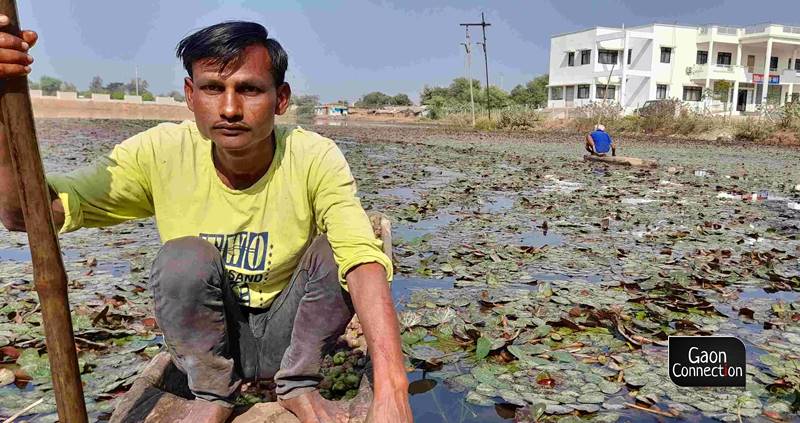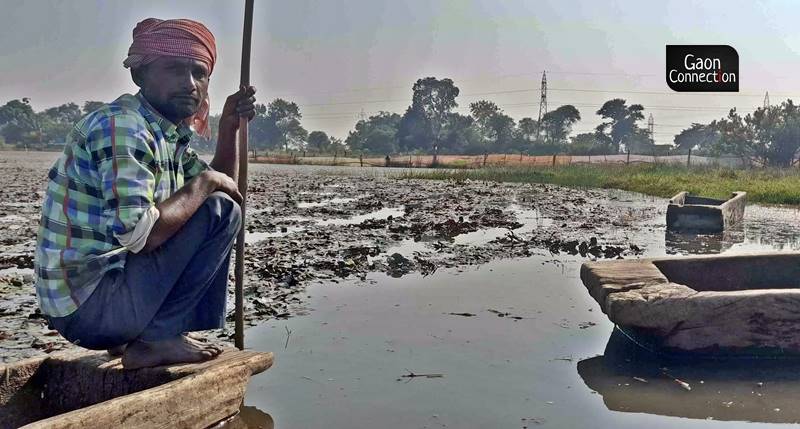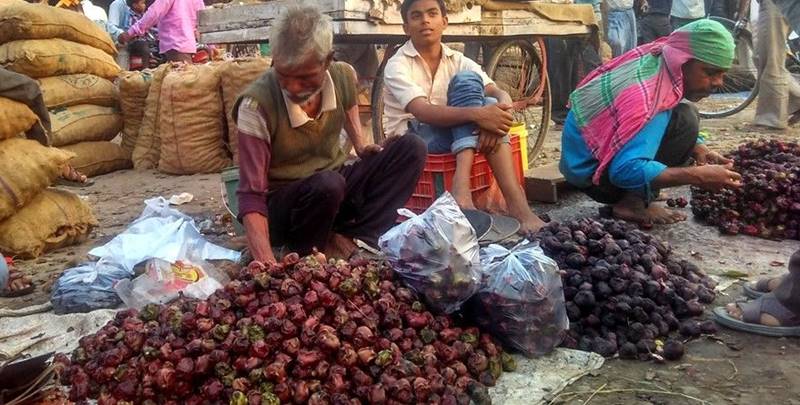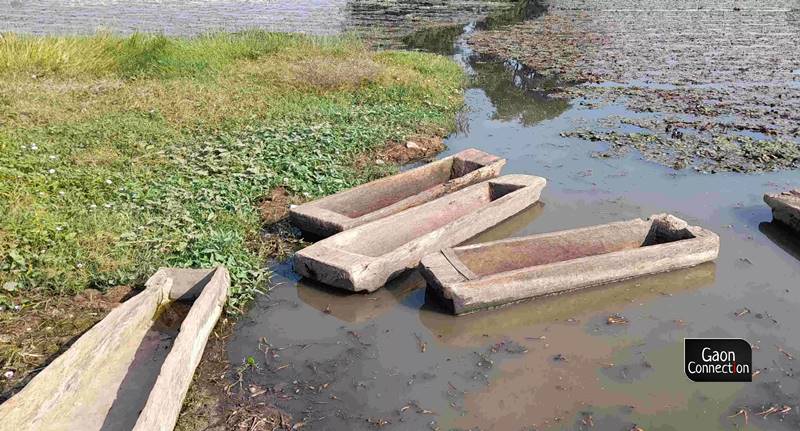Water chestnut is 10 times costlier than it was 35 years ago — but have the cultivators benefitted?
Farmers in the barren areas of Madhya Pradesh rely on cultivating singhara (water chestnut) in the local ponds. These farmers say that despite a ten-fold increase in its market price, their livelihoods have not improved. Read on to know more.


Satna/Rewa (Madhya Pradesh)
Ramsiya Kewat, a 65-year-old landless farmer has cultivated singhara (water chestnut) all his life. He often wonders why his living standards have not improved despite a ten-fold rise in the selling price of singhara in the last 35 years. He remembers a time when hundred pieces of the fruit were sold for eight rupees and at present, he gets Rs 80 for the same quantity.
“All I have inherited from my ancestors is the skill to grow singhara in the ponds. But I don’t own a pond either. I take an acre (half an hectare) of the pond on a yearly rent of fifteen thousand rupees and cultivate singhara in it. It’s the only source of income in my household,” Kewat, a resident of Simariya village in Madhya Pradesh’s Rewa district, told Gaon Connection.
“The pond is about three kilometres from my house. I use a bicycle to go to the pond and also load the singharas on it in order to sell them in the village market. The cycle needs urgent repairs but I have not been able to afford it for years… I have seen the prices of my crop increase by ten times in the last thirty years, yet there’s no improvement in our lives” he added.
Also Read: When Guddu, a water chestnut farmer, taught lessons on urban wastewater and agricultural livelihoods

When asked about switching to other crops, the 65-year-old said in his irritated voice — “Banjar zameen hai hiyan. Kachau na hote. Aur kaahe k liye singhada ki kheti karat hain”. (The land is not fit for farming here, why else would we grow singhara)
A heap of singhara (water chestnuts) placed on a cart is a common sight when visiting a roadside vegetable market during the winter months in northern India. Known for being slightly sweet with a fruity crunch and packed with essential minerals, singhara is a fruit that is eaten in diverse forms.
Also Read: With third highest inland fish production, Uttar Pradesh coming up as a major fisheries hub
It is eaten raw as well as boiled and its dried form is grounded to produce flour which is used for making potato-filled fried flat breads (pooris) and fritters — popular among the Hindus who widely consume it during ritualistic fasting festivals such as the Navratra.
‘People who bargain have no idea what it takes to grow singhara’
Kewat told Gaon Connection that cultivation of singhara requires seven months of hard work. “It takes four months for the plant to grow into its full size and another three to produce fruit,” he informed.
“The sowing season begins in the summer months of May- June. We plant the seed in a small puddle or a small water body. Within a month, the plant grows into a vine which is then transplanted into the larger pond,” the farmer added. The fruit is harvested in the months of December-January.

The farmer’s son Rakesh Kevat, who helps his father in cultivation, pointed out that apart from the hard work required to raise the crop, the expenses on the insecticides determine their profits immensely.
“The biggest expense is the keeda-maar dawa (insecticides). As the entire plant grows in water, the risk of insects spoiling the crop is too high. We constantly have to use dawa to protect the crop. The expenses cost us thirty thousand rupees in a year,” Rakesh Kevat said.
Having seen his father cultivate singhara all his life, Rakesh wishes to do something else but cannot think of leaving his ageing father alone to cultivate the fruit.
“When the crop is harvested, I also work as a labourer in the nearby cities like Rewa. It supports our livelihood but singhara is our main source of income. If all goes well and we harvest about tees quintals (3,000 kilogrammes) of the fruit, we earn a profit of about fifty thousand rupees in a year,” Rakesh explained.
“ But that is the maximum profit we earn… usually it’s less than this. Also, when we sell it in the mandis, people bargain a lot. It hugely impacts our profit. These people have no idea of what it takes to cultivate singhara,” he added.

He also informed that a kilogram of singhara seed costs Rs 100 and it gives out almost 25 kilogrammes of the fruit.
‘We make our own boats to look after the crop’
The districts of Rewa and Satna are known for water-chestnut cultivation and there are villages where its cultivation is the mainstay and supports the rural economy.
About 75 kilometres away from Kevat’s village lies Sohaula — a village in Satna district that houses about 70 families whose livelihoods depend on water chestnut cultivation.

Ramanuj Singarha is one such farmer in the village who cultivates singhara. He pointed out that farmers like him are skilled boat-makers as well.
“We use a tree stem to make our own boats. These boats are not very big but are vital for attending the crop and also harvesting it. We spend as many as five to six hours on these boats in a day,” Singarha told Gaon Connection.
The farmer informed that he belongs to the mallah (fisher) community and Nishad was the title they used earlier but over a period of time, their surnames have changed to Singarha due to singhara cultivation.
“It costs around four to five thousand rupees to make a boat. Despite the hard work it takes to cultivate singhara, we do not get just prices in the market,” he said.
Also Read: Fish feed made from litchi seeds to cut costs for the fish farmer by 25%
Rohini Mallah, another farmer, told Gaon Connection that the boat they make is five feet long and around half a metre wide.
Unrecognised by the government
Interestingly, the Indian Council of Agriculture Research (ICAR) has no data on the cultivation of water chestnuts in the country.
When Gaon Connection contacted an official from the Department of Horticulture and Food Processing in Satna, he informed that data on the number of singhara farmers has never been asked before and the department doesn’t maintain a record of it.
“We do not maintain formal data for these farmers. But according to unofficial estimates, there are about 1,500 farmers who cultivate singhara,” Narendra Singh Kushwaha, assistant director of the department in Satna district, told Gaon Connection.
Since the fruit is grown in stagnant water bodies like ponds, which fall under the fisheries department, Gaon Connection also talked to the department whose official stated that the department keeps track of fish farmers who also grow water chestnuts.
“Some fish farmers grow this crop as it is also used as a fish feed. In Satna, areas near Amarpatan, Sohawal, Unchehra and Meher have ponds where some farmers grow singhara,” Anil Srivastava, assistant fisheries officer in Satna told Gaon Connection.
The official also informed that there are a total of 1,738 ponds in the district which cover an area of 6957.992 hectares.

